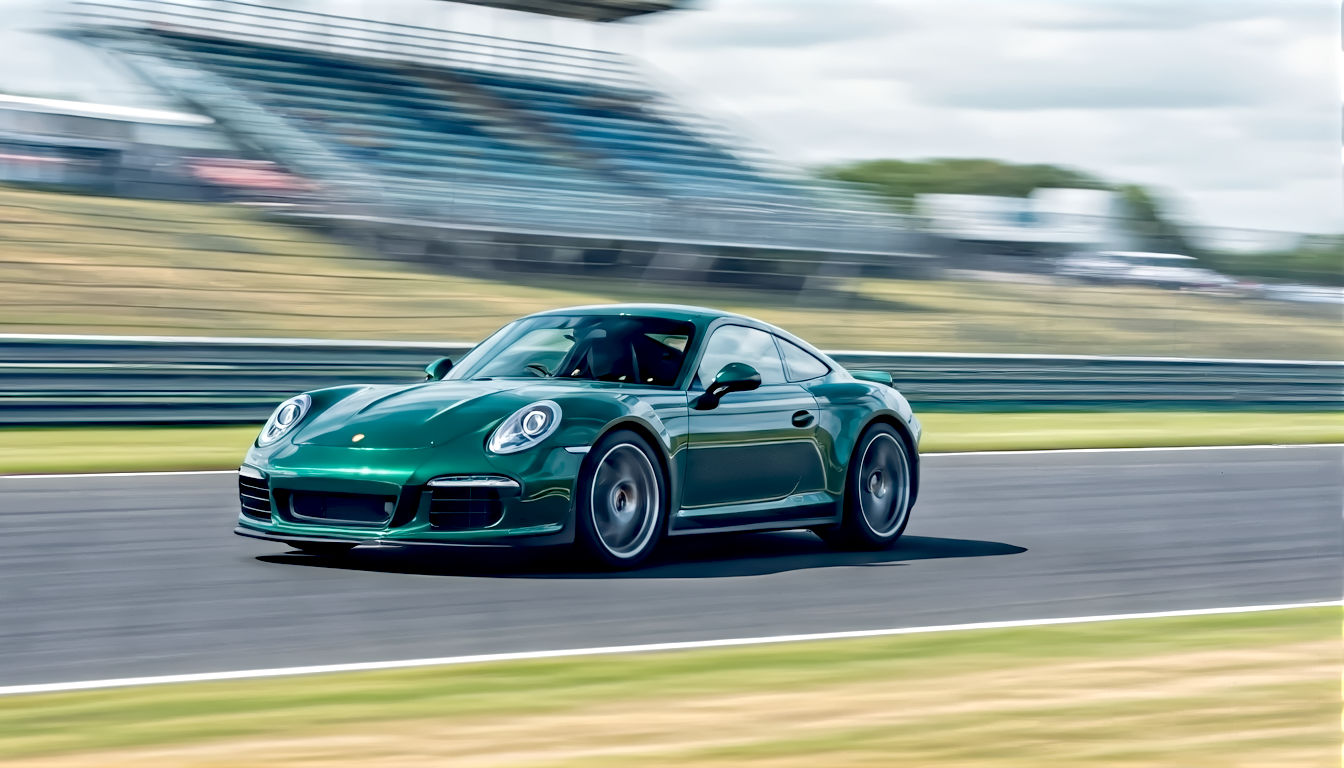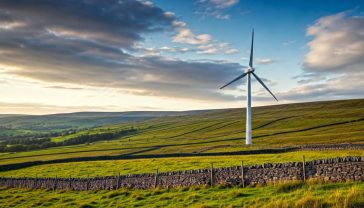From Blurry Mess to Blistering Motion: The Guide to Panning Photography
Your definitive guide to mastering panning photography. Learn the essential camera settings, core techniques, and common fixes to create stunning action shots.

This post may contain affiliate links. If you make a purchase through these links, we may earn a commission at no additional cost to you.
Ever seen one of those brilliant photos where a speeding racing car or a cyclist is perfectly sharp, but the background is a slick, blurry streak of motion? It’s a trick that screams speed, action, and energy. That, my friend, is panning, and it’s one of the most rewarding techniques you can master in photography. It might look dead complicated, but don’t you worry. By the time you’ve finished this guide, you’ll be able to turn a blurry mess into a masterpiece.
Panning isn’t just for the pros with massive lenses at Silverstone. You can do it with your dog sprinting across the park, your kids tearing around on their scooters, or even the number 73 bus trundling down Oxford Street. It’s all about capturing movement in a way that feels dynamic and alive.
This isn’t some dry, technical manual. Think of this as a friendly chat with a mate who’s figured it out and wants to share the secrets. We’ll break it down step-by-step, from the basic kit you’ll need to the exact settings that will get you started. We’ll talk about how to stand, how to move, and how to avoid the common wobbles and woes that trip everyone up at first. So, grab your camera, and let’s get moving.
What on Earth is Panning, Anyway?
Right, let’s get the basics sorted. Panning is a photography technique where you move your camera to follow a moving subject. The idea is to keep your subject in the same spot in your viewfinder as it travels past you.
Imagine you’re watching a tennis match. Your head turns to follow the ball as it flies from one player to the other. Panning is exactly that, but with a camera.
When you do it right, something magical happens. Because you’re moving your camera at the same speed as your subject, the subject stays sharp and in focus. But because the camera is moving relative to the background, everything behind your subject—the trees, the crowd, the buildings—blurs into lovely, smooth streaks of colour. This effect is called motion blur.
Why Bother with Panning?
So, why not just use a super-fast shutter speed and freeze everything? You could, but that often makes for a static and, dare I say, slightly boring photo. A picture of a Formula 1 car frozen perfectly still on the track doesn’t really tell you it was hurtling along at 200 miles per hour. It could be parked.
Panning does two brilliant things:
- It Screams “Speed!”: The motion blur in the background instantly tells your brain that the subject is moving, and moving fast. It adds a massive dose of energy and excitement.
- It Makes Your Subject Pop: When the background is a soft, artistic blur, your sharp subject stands out a mile. It isolates them from any distracting clutter in the background, forcing the viewer’s eye exactly where you want it.
Think of it as the difference between a statement and a story. A frozen-action shot is a statement: “Here is a car.” A panning shot tells a story: “Here is a car blasting down the road.”
The Kit You’ll Need (Hint: It’s Less Than You Think)
Good news! You don’t need to remortgage your house to get started with panning. While fancy gear can help, you can get cracking with the basics.
The Camera
Any camera that lets you control the shutter speed will do the job. This is the one non-negotiable.
- DSLR or Mirrorless Camera: These are ideal because they give you full manual control. You can dial in the exact shutter speed, aperture, and ISO you need. Brands like Canon, Nikon, Sony, and Fujifilm all have brilliant options.
- Bridge Camera: Many of these ‘superzoom’ cameras have a Shutter Priority mode, which is perfect for panning.
- Compact Camera (Point-and-Shoot): Some high-end compacts have manual controls or a ‘Sports’ scene mode that might work. Check your camera’s manual for a setting that lets you influence the shutter speed.
- Smartphone: This is the trickiest, but not impossible! Newer phones, like iPhones and Google Pixels, have clever software. You might need a third-party app (like ProCamera for iPhone or Open Camera for Android) to manually set a slower shutter speed. Some phones also have a ‘panning’ mode built into their camera app.
The Lens
You don’t need a lens the size of a telescope.
- Kit Lens: The lens that came with your camera (like an 18-55mm) is a great place to start. It’s versatile and lightweight, making it easy to swing around.
- Telephoto Lens (e.g., 70-200mm): A longer lens is fantastic for subjects that are further away, like cars on a racetrack or birds in flight. The longer the lens, the more compressed the background blur will look, which can be very dramatic. However, they are heavier and harder to hold steady.
- Prime Lens (e.g., 50mm): A prime lens has a fixed focal length (it doesn’t zoom). They are often sharp and lightweight, but you’ll have to ‘zoom with your feet’ by moving closer or further away.
One extra tip: if your lens has Image Stabilisation (IS) or Vibration Reduction (VR), check if it has a ‘Mode 2’ or a ‘panning’ setting. This special mode tells the lens to only stabilise for up-and-down wobble, not the side-to-side movement you’re deliberately creating. If it doesn’t have a panning mode, it’s often best to switch IS/VR off completely, as it can sometimes try to ‘correct’ your smooth pan and make the photo jerky.
Nice-to-Have Extras
- Monopod: This is a one-legged stand that helps take the weight of a heavy camera and lens. It gives you support for the vertical movement (up and down) while allowing you to pivot smoothly from side to side. It’s a game-changer for long days at a motorsport event.
- Neutral Density (ND) Filter: This is like a pair of sunglasses for your lens. It cuts down the amount of light entering the camera. Why would you want less light? On a bright sunny day, even at a low ISO, your chosen slow shutter speed might let in too much light, overexposing your photo. An ND filter lets you keep that slow shutter speed without blowing out the highlights.
Getting Started: The Core Technique
Right, theory over. Let’s get our hands dirty. The physical act of panning is a bit like a golf swing or throwing a ball—it’s a smooth, fluid motion that comes from your whole body, not just your arms.
Step 1: Find Your Spot
First, you need to pick a good location. You want a clear view of your subject’s path. Stand parallel to the line of travel. If you’re photographing a car on a road, stand on the pavement, not facing the car head-on.
Also, think about the background. A busy, colourful background with lots of different elements (like a forest, a crowd of people, or a row of shops) will create much more interesting blurry streaks than a plain blue sky or a single-coloured wall. A bit of texture and variety is your friend here.
Step 2: Get Your Stance Right
This is more important than it sounds. A solid stance is the foundation of a smooth pan.
- Plant Your Feet: Stand with your feet about shoulder-width apart. This gives you a stable base.
- Face Forward: Your feet should point towards the middle of the area where you’ll be taking the picture, not where the subject is coming from.
- Tuck Your Elbows In: Keep your elbows tucked into your sides. This braces the camera against your body and reduces wobble.
- Hold the Camera Correctly: Use your right hand to grip the camera body and your left hand to support the lens from underneath. This two-handed grip is crucial for stability.
Step 3: The Panning Motion
The magic is all in the movement. You need to twist from your waist, keeping your upper body, arms, and camera locked together as a single unit. Don’t just move your arms or your head.
- Pick Up the Subject Early: As your subject comes into view, raise the camera to your eye and find it in the viewfinder. Start tracking it well before you intend to press the shutter button.
- Swing from the Hips: Begin twisting your torso smoothly to follow the subject. Your whole upper body should move as one. The aim is to match its speed perfectly, so it stays in the same position in your frame.
- Squeeze the Shutter: When the subject reaches your ideal spot (usually when it’s directly in front of you), gently squeeze the shutter button. Do not jab at it! A sharp jab will jerk the camera and ruin the shot.
- Follow Through: This is the secret sauce. Do not stop moving the moment you hear the click. Continue the smooth panning motion until long after the shutter has closed. Just like a golfer completes their swing, you must complete your pan. Stopping abruptly is the number one cause of blurry subjects.
It’s a three-part rhythm: Track… Squeeze… Follow through. Practice this motion a few times without even taking a photo, just to get a feel for it.
Dialling in Your Camera Settings
Okay, you’ve mastered the panning dance. Now let’s tell the camera what we want it to do. The key is balancing shutter speed, aperture, and ISO to get that perfect mix of a sharp subject and a blurred background.
We’ll use Shutter Priority Mode, which is S on most cameras, or Tv (Time Value) on Canons. In this mode, you choose the shutter speed, and the camera automatically figures out the best aperture for a correct exposure. It’s the perfect mode for learning to pan.
Shutter Speed: The Heart of Panning
The shutter speed is the length of time the camera’s sensor is exposed to light. For panning, we need a relatively slow shutter speed. This is what allows the background to blur as you move the camera.
But how slow is slow? There’s no single magic number. It depends on three things:
- The speed of your subject: The faster it’s moving, the faster your shutter speed can be.
- The distance to your subject: The closer you are, the faster it seems to move across your frame, so you might need a faster shutter speed.
- How much blur you want: For a super-smooth, abstract blur, you need a very slow speed. For just a hint of motion, you can use a slightly faster one.
Here’s a rough guide to get you started. Think of these as starting points, not rules.
| Subject | Suggested Shutter Speed Range |
|---|---|
| People walking, slow joggers | 1/15s to 1/4s |
| People running, kids on scooters, cyclists | 1/60s to 1/15s |
| Dogs sprinting, motorbikes on a city street | 1/125s to 1/30s |
| Fast-moving cars, motorsport | 1/250s to 1/60s |
Pro Tip: Start with a “safer” shutter speed (like 1/125s for a car) to get some sharp shots in the bag. Once you’re feeling confident, start lowering the speed (to 1/60s, then 1/30s) to increase the amount of background blur. The slower you go, the harder it is to keep the subject sharp, but the more dramatic the effect will be.
Focus Mode: Nailing the Sharpness
Getting a moving subject in focus is a big challenge. Your camera has some clever tools to help. You need to use Continuous Autofocus.
- This mode is called AF-C on Nikon, Sony, and Fujifilm cameras.
- It’s called AI Servo on Canon cameras.
In this mode, when you half-press the shutter button, the camera will continuously track and refocus on your subject as it moves. This is essential for panning.
For the autofocus area, try using a Single Point AF or a Dynamic Area/Zone AF. Place this single focus point over your subject (e.g., the driver’s helmet in a racing car, or the head of a cyclist) and keep it there as you pan. This tells the camera exactly what you want to be sharp. Avoid using the wide, fully automatic AF mode, as the camera might get confused and focus on the background by mistake.
Drive Mode: Fire in Bursts
Set your camera to its Continuous Shooting or Burst Mode. This is often shown as an icon of overlapping rectangles.
Instead of taking one single picture, the camera will fire off a rapid sequence of shots as long as you hold the shutter button down. Why is this good? Because it massively increases your chances of getting a “keeper.” Out of a burst of 5-10 photos, one of them is much more likely to have the subject perfectly sharp at the peak moment of action. You can’t time a single shot that perfectly, so let the camera do the heavy lifting.
Aperture and ISO
Because you’re in Shutter Priority mode, the camera will choose the aperture for you. However, you should keep an eye on it. If the camera is choosing a very wide aperture (like f/2.8) on a sunny day, you might not get the whole subject sharp. You can influence this by adjusting the ISO.
- ISO: Set your ISO to the lowest native setting, usually ISO 100 or ISO 200. We only want to increase this if it’s getting dark and the camera can’t get a proper exposure otherwise. Keeping the ISO low gives you the best image quality.
- Auto ISO: Many modern cameras have an excellent Auto ISO feature. You can set it to stay within a certain range (e.g., 100-1600) and it will adjust automatically to the light. This can be handy if the light is changing, for example, as a car drives from a sunny patch into a shady area.
Common Problems and How to Fix Them
Don’t get frustrated if your first few hundred shots aren’t perfect. Panning has a steep learning curve, but once it clicks, it really clicks. Here are some common gremlins and how to squash them.
Problem: My whole photo is a blurry mess.
- The Cause: Your shutter speed is probably too slow for your current skill level, or your panning motion isn’t smooth. You might be stopping your pan too early.
- The Fix:
- Increase your shutter speed. If you were at 1/15s, try 1/60s. Get a sharp shot first, then work your way slower.
- Practice the motion. Remember: Track, Squeeze, Follow Through. That follow-through is vital.
- Check your stance. Make sure you’re twisting from your waist and your elbows are tucked in.
Problem: The background is sharp but my subject is blurry.
- The Cause: Your panning speed doesn’t match the subject’s speed. You are panning too slowly or too quickly.
- The Fix: This is purely down to practice. You need to train your body to perfectly synchronise with the subject. Try to keep the subject locked in the exact same spot in your viewfinder throughout the entire pan.
Problem: My subject is sharp, but the background isn’t very blurry.
- The Cause: Your shutter speed is too fast.
- The Fix: Easy one! Lower your shutter speed. If you were at 1/250s, try 1/125s or 1/60s. The slower you go, the creamier that background blur will become. Also, a background with more detail and distance from the subject will blur more effectively.
Problem: My photos are too bright (overexposed).
- The Cause: It’s a sunny day and your slow shutter speed is letting in too much light. The camera has already set the narrowest aperture (e.g., f/22) and can’t go any further.
- The Fix:
- Make sure your ISO is at its lowest setting (e.g., ISO 100).
- If it’s still too bright, this is where an ND filter comes in. Pop one on your lens to reduce the light and allow you to keep that lovely slow shutter speed.
Creative Panning Ideas to Try
Once you’ve got the hang of the basic technique, you can start getting creative.
- Panning with a Flash: Try using a flash on a low power setting. This will fire a little pop of light that freezes your subject, making them extra-crisp against the motion-blurred background. It’s a technique called rear-curtain sync that can look amazing, especially at dusk.
- Vertical Panning: Who says you can only pan from side to side? Try it with something moving up or down. A person jumping on a trampoline, a child on a swing, or a lift going down the side of a building. The same principles apply, just in a different direction.
- Intentional Blur: Deliberately use a very slow shutter speed (like 1/4s or even 1 second) and accept that your subject won’t be perfectly sharp. This can create a beautiful, abstract, and painterly image full of colour and motion. It’s great for things like the London Underground rushing past or fairground rides at night.
- Panning in Circles: For a real challenge, try panning with something that’s spinning, like a carousel or a dancer. You’ll need to move your body and camera in an arc to match the movement.
Where to Practise in the UK
The UK is a brilliant place to practise your panning skills. You’re never far from something that moves!
- Local Parks: Your local park is a fantastic training ground. Practise on dogs chasing balls, joggers, cyclists, and kids on scooters. They move at manageable speeds.
- City Centres: Find a busy road (safely from the pavement, of course!) and practise on buses, taxis, and cyclists. London’s red buses, in particular, make for iconic panning shots.
- Motorsport Venues: For the ultimate panning challenge, head to a racetrack. Places like Brands Hatch in Kent, Silverstone in Northamptonshire, or Oulton Park in Cheshire are meccas for motorsport fans. You’ll have endless fast-moving subjects to shoot. Find a spot on a slower corner to begin with, as it’s easier to track the cars there.
- Tourist Spots: Places with lots of movement are ideal. Think about the trams in Manchester or Edinburgh, or boats on the Thames.
A Final Word
Panning is one of those photographic skills that is immensely satisfying to get right. It takes patience and a lot of practice. You will take hundreds of bad photos. Everyone does. But don’t see them as failures; see them as practice runs. Each blurry mess teaches you something about your timing, your movement, or your settings.
The key is to not give up. Get out there, find something that moves, and start shooting. Experiment with different shutter speeds, different subjects, and different locations. Soon, that smooth, fluid motion will become second nature, and you’ll be creating dynamic, action-packed images that truly capture the feeling of speed.
Now, stop reading and get panning!
Further Reading
For those who want to dive even deeper, here are some of the most respected resources in the photography world:
- Digital Photography School: A fantastic resource for tutorials on all aspects of photography, including panning.
- Cambridge in Colour: A more technical and in-depth site that explains the science behind photography concepts with excellent, clear examples.
- DPReview: Known for its incredibly detailed camera and lens reviews, its forums and articles are a goldmine of information for enthusiasts.
- Fstoppers: A community-based site with news, reviews, and behind-the-scenes articles from professional photographers.






